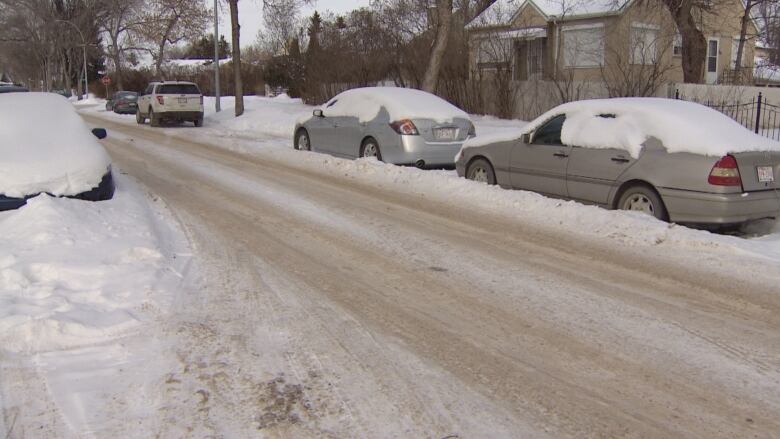'No magic bullet': city considering options for improved snow removal
Separate trial program to improve winter walking also being considered

Plowing, salt, sand and brine:when it comes to clearing Edmonton's roads,it's about finding the right tool for the right conditions.
"There's no magic bullet," Janet Tecklenborg, the city's infrastructure operations director, saidWednesday following the release ofan update on the city's snow and ice controlpilot project.
The document is set to go to city council's community and public services committee on June 26.
After a limited launchin 2016, the snow and ice control pilot has expanded. With an aim to reach bare pavement on priority roads, it has tested a variety of snow removal methods, including a controversial calcium chloride brine.
Wednesday's update,the first of two, focused on literature reviews, comparisons to the programs of other Canadian cities and public engagement.
Public opinion has been mixed.
"Overall, the public expressed concern that the quality of the winter road maintenance program in residential areas has decreased in recent years," the report said.
People surveyed by the city said they want:
- Greater focus on snow removal and maintaining full driving lanes, especially on busier roads.
- More attention to sidewalks enforcing existing rules and having the city hold itself to the same standards it expects of residents.
- Mandatory parking bans in residential areas, with "tag and tow" or using odd/even house numbers to designate parking.
- Providing a bigger budget to the program as the city grows.
- Better communication and education about the program.
"We're going to propose options based on that feedback to potentially pilot in some of the residential areas for next winter," Tecklenborg said. "But just to be clear, the pilot in residential areas would not include any kind of anti-icers or de-icers. These are just looking at other options that we can pilot in residential areas."
Wider winter driving lanes
A residential pilot program would achieve wider winter driving lanes by creating "windrow free zones," the report said. But getting down to bare pavement on residential roads by using salt and brine would not be a priority.
Administration will also consider a trial program to improve winter walking in the city, through a community equipment sharing program, a volunteer program for sidewalk clearing, and "re--prioritizing select walkways."
- Public feedback could guide changes to Edmonton's snow clearing policy
- Ice and snow complaints surge during week of freezing rain
- Edmonton focuses on goal of bare pavement in snow removal
Edmonton has about 12,000 "lane kilometres" of roads, and in 2018 spent $66 million on winter road maintenance.
The report details some of the benefits and downsides of the city's current snow and ice control measures, including anti-icing, de-icing, sand, salt and plowing.
The report notes changing weather patterns due to climate change, creating warmer, wetter winters with periods of deep cold. On top of more freeze-thaw cycles, more freezing rain is also expected. Snow removal must be "adaptive to respond to the impacts of climate change," it said.
This winter, the anti-icing brine was used only twice, compared to 10 times in 2017-2018. Temperatures consistently below -20 C, more instances of freezing rain and pavement that wasn't dry were not conducive to its use.
"Ultimately, what we want people to understand is everything we do as part of our snow and ice program to get to safe and accessible roads has a tradeoff," Tecklenborg said. Sand, once the city standard, has become "basically the new asbestos," she said, with both detrimental health and environmental impacts.

Materials used in 2018/19 included 42,000 tonnes of salt, 49,000 tonnes of sand, 617,000 litres of calcium-chloride brine and more than 8,000 plow blades.
Calcium chloride use was down significantly from the previous winter, when the city used nearly 4.7 million litres of brine on roadways.
Salt use was up slightly from 2017/18, when 37,000 tonnes was used.
The focus for 2018/19 was on using "the right tool for the right conditions" to achieve bare pavement, the report says.
Preliminary environmental monitoring shows anti-icer and de-icer materials "have no apparent impact on stormwater discharged into the North Saskatchewan River," it adds.
Seven claims were made to the city for property and vehicle damages caused by de-icing in 2017 and 2018, but none of them were validated, the report said.
Next report in August
A follow-up report is expected in August, with detailed results from lab and field research on the benefits and trade-offs of the pilot program on road safety, infrastructure and the environment.
Research outlined in the two reports "will inform any potential changes to the [snow and ice control] policy and program for next winter," the city says.
Next week's meeting will also see a report showing that in the period from Oct. 1, 2018 until March 31, 2019, the city's 311 service fielded 34,547 inquiries related to snow and ice.
Nearly 6,900 calls were about bylaw enforcement, more than 10,000 were about sanding, 8,500 were about snow clearing and 5,400 were about windrows.












_(720p).jpg)


 OFFICIAL HD MUSIC VIDEO.jpg)
.jpg)



























































































